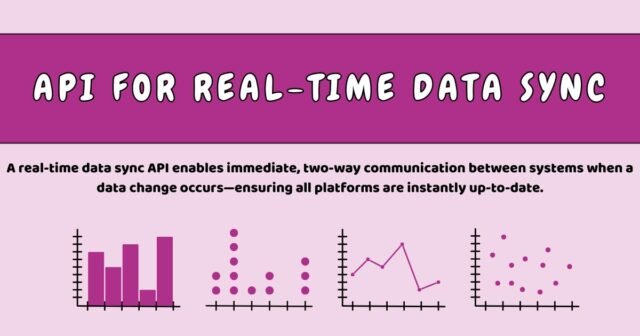Why Real-Time Data Sync Matters More Than Ever
In a world that runs on data, milliseconds matter. Whether you’re managing a growing SaaS product, building a real-time dashboard, or powering IoT devices, one thing is clear: real-time data synchronization is no longer optional—it’s foundational.
As businesses move toward microservices, event-driven architectures, and cross-platform user experiences, APIs are the glue that connects it all. But not just any APIs—real-time data sync APIs make the difference between lagging behind and leading with live, responsive, and consistent data systems.
In this guide, we’ll explore what these APIs are, how they work, the best options on the market, and how to choose the right one for your organization.
The Problem: Traditional Sync Methods Are Failing
Scheduled syncs, batch updates, and manual data pushes might have worked in the past—but today, they create bottlenecks.
Here’s what’s going wrong:
-
Latency delays decisions
-
Inconsistency leads to broken user experiences
-
Manual overhead drains development teams
-
Scaling limitations restrict growth
If your app updates product inventory every 30 minutes instead of every few seconds, you’re not keeping up. That’s where real-time sync APIs step in.
The Solution: What Is a Real-Time Data Sync API?
A real-time data sync API enables immediate, two-way communication between systems when a data change occurs—ensuring all platforms are instantly up-to-date.
These APIs typically use:
-
WebSockets for full-duplex communication
-
Event-driven Pub/Sub APIs for many-to-many sync
-
Streaming over HTTP for simple real-time updates
-
CDC (Change Data Capture) via REST or Kafka-style APIs
They allow seamless integrations between cloud applications, databases, mobile apps, and IoT devices without lag or manual intervention.
Top APIs for Real-Time Data Synchronization in 2025
Let’s dive into the most reliable and scalable APIs that development teams trust for real-time data syncing.
1. PubNub
What It Is:
A globally distributed, low-latency publish/subscribe messaging API.
Features:
-
Real-time messaging at scale
-
Supports over 70 SDKs and languages
-
End-to-end encryption
-
Presence detection and history logging
Use Cases:
-
Live chat
-
IoT sensor streaming
-
Online collaboration platforms
Best For: Teams looking for fast setup and robust cloud infrastructure.
2. Firebase Realtime Database
What It Is:
A Google-hosted NoSQL cloud database with built-in real-time syncing.
Features:
-
Syncs JSON data in real-time
-
Offline support
-
Handles conflict resolution automatically
Use Cases:
-
Mobile messaging apps
-
Realtime forms
-
Multiplayer gaming states
Best For: Developers building mobile and web apps with minimal backend setup.
3. Kafka Connect API
What It Is:
Part of Apache Kafka’s ecosystem, this API connects external data sources to Kafka topics in real-time.
Features:
-
High-throughput pipelines
-
CDC connectors for major DBs
-
Real-time ingestion into data lakes
Use Cases:
-
Stream processing
-
ETL pipelines
-
Real-time dashboards
Best For: Enterprises managing large-scale data ingestion and stream processing.
4. Debezium (CDC via REST or Kafka)
What It Is:
An open-source platform for change data capture.
Features:
-
Monitors databases for row-level changes
-
Streams changes into Kafka topics or REST endpoints
-
Supports MySQL, PostgreSQL, MongoDB, and more
Use Cases:
-
Replication
-
Event sourcing
-
Microservices state synchronization
Best For: Backend teams syncing large databases in real-time with minimal performance impact.
5. SnapLogic API Integration
What It Is:
An integration platform offering low-code real-time data movement between SaaS, cloud, and on-prem systems.
Features:
-
Visual workflow builder
-
600+ connectors (“Snaps”)
-
Real-time and batch pipelines
Use Cases:
-
CRM ↔ ERP sync
-
HR → Analytics sync
-
Multi-app automation
Best For: Businesses looking for low-code, enterprise-grade API connectivity.
Real-World Use Cases That Prove the Value
E-Commerce Inventory Management
An e-commerce site uses Firebase or Kafka Connect to ensure that any change in warehouse stock is instantly reflected in product listings, preventing overselling.
Live Chat and Collaboration Tools
PubNub powers live messaging with typing indicators, delivery status, and notifications in real time across platforms.
Financial Systems
Debezium connects the central ledger with customer dashboards and compliance tools, offering sub-second transaction visibility.
IoT Device Streams
An industrial automation firm uses Pub/Sub APIs to stream data from thousands of sensors, providing instant alerts for system anomalies.
Key Features to Look for in a Real-Time Sync API
| Feature | Why It Matters |
|---|---|
| Low latency (<100ms) | Ensures responsive UI and faster processing |
| Bi-directional communication | Keeps all endpoints updated |
| SDK availability | Reduces development time |
| Security protocols | Protects sensitive data (OAuth, TLS, etc.) |
| Scalability | Handles growth without rewrites |
Choosing the Right API for Your Business
When selecting a real-time data sync API, consider the following:
-
Data Type: Are you syncing documents, database rows, or device data?
-
Latency Requirements: Do you need milliseconds or is a few seconds acceptable?
-
Scale: How many systems, users, or devices will communicate?
-
Technical Stack Compatibility: Does the API fit with your architecture?
-
Security & Compliance: Do you need data encryption, GDPR compliance, etc.?
For lightweight mobile sync, Firebase may be best.
For high-scale backend integration, Kafka + Debezium offers the most control.
For low-code integration, SnapLogic simplifies implementation.
Best Practices for Real-Time API Implementation
-
Use retries and failover logic to handle dropped connections.
-
Monitor delivery metrics and sync health to avoid data loss.
-
Implement versioning in your API to avoid breaking changes.
-
Plan for eventual consistency when full ACID compliance isn’t realistic.
-
Secure all endpoints using encryption, access tokens, and audit trails.
Final Thoughts: The Future Is Real-Time
As applications become more connected and expectations rise, real-time data synchronization is becoming the new standard. APIs that enable fast, efficient, and secure syncing are the foundation for modern digital ecosystems.
Whether you’re managing a few microservices or orchestrating global data pipelines, choosing the right real-time sync API ensures your systems stay fast, responsive, and reliable.
For organizations ready to scale and automate with live data, the time to adopt a real-time sync strategy is now.







